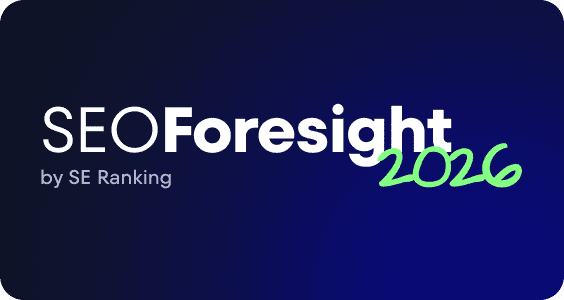AI Mode research: Volatility, source patterns, and differences from AIO and organic results
No Google I/O goes by without major announcements, especially those centered around changes in search.
This year, Google rolled out AI Mode (AIM) to users in the US. Equipped with advanced reasoning and multimodal features, Google’s new AI search tool handles multi-part questions and generates structured responses. AI Mode breaks down your query into subtopics and performs multiple parallel searches (query fan-out) to produce a unified answer with links and citations.
In our June 2025 study, we revealed how volatile AIM results are, how rarely they align with traditional organic rankings, and how they rely on a unique set of trusted domains to craft answers.
Now, just a month later, AI Mode is no longer limited to the US. It’s available in 180 countries in English. This expansion makes it more urgent than ever for marketers and businesses to understand how AIM works and what it means for their visibility. That’s why we encourage you to dive into the details of our research below.
And once you’re ready to take the next step, not just to understand but to control how your brand shows up in AI Mode, meet the AI Mode Tracker. With this tool, you can monitor your brand’s presence in Google’s AI-generated responses in real time and turn AI visibility into a competitive advantage:
- Track how and when your brand appears in AI Mode, even when only mentioned and unlinked.
- See which of your pages are cited, so you know what content resonates.
- Compare your AI visibility with competitors, from share of mentions to link prominence.
- Check out the full AI-generated answer and all the sources it links to.
Now, back to our AI mode study. Back in June, we analyzed 10,000 keywords. Here’s what we found:
-
AI Mode and AI Overviews share a response overlap in 10.7% of URLs and 16% of domains.
-
Overlap between AIM and organic results is also limited: 14% at the URL level and 21.9% at the domain level when compared with the organic top 10.
-
Volatility is high. Even the same query run multiple times on the same day often yields different sources. Only 9.2% of URLs matched across three tests.
-
On average, each AI Mode answer contains 12.6 links.
-
90.8% of citations appear in separate blocks, and 8.9% are inline text links.
-
0.3% of citations are so-called AIM SERP links, mimicking organic results.
-
Google leads in AI Mode citations, accounting for 5.7% of all sources. It also dominated across all three datasets with slight fluctuations (between 5.5% and 5.7%). And 98% of its links are embedded in AI Mode text responses.
-
97.9% of Google links point to Google Maps business profiles, showing business information. These links appeared in 9.2% of responses.
-
Top-cited domains are relatively stable. Sites like Indeed, Wikipedia, Reddit, and YouTube consistently appear at the top across all datasets.
Disclaimer:
This study is based on 10,000 keywords from US locations. We focused on AIM sources, volatility, and its similarities or discrepancies with AI Overviews and traditional organic search results.
AI Mode is a new and growing system, so these findings reflect its behavior during the specific time period and keyword set. Because the system changes frequently, the outcomes could vary under different conditions or at a later time.
The insights shared in this report reflect our analysis and perspective. We recognize that other valid interpretations may exist.
For a detailed explanation of how this research was carried out, please refer to the methodology section at the end of this article.
How many sources do AI Mode’s answers contain?
On average, each AI Mode response includes 12.6 URLs (sources). Across 9,734 triggered responses, AI Mode used a total of 122,617 links to support its answers. Comparing this result with AI Overviews, we see a slight difference of 0.7% with AIOs citing 13.3 URLs (sources) on average.
What’s the link count distribution in AI Mode answers?
We looked at the number of references contained in each AI Mode response. We found the following distribution:
- 11–15 links: the most common range, with 3,443 responses (35.4%)
- 6–10 links: also common, with 2,923 responses (30%)
- 16–20 links: found in 1,810 responses (18.6%)
Our recent research on AIOs showed a similar picture, where AIOs cited 6-14 links per response most frequently.
- 0-5 links: 8% of cases
- 6-10 links: 30% of cases
- 11-15 links: 35.4% of cases
- 16-20 links: 18.6% of cases
- 21-25 links: 5.6% of cases
- 26-30 links: 1.8% of cases
- 31-35 links: 0.4% of cases
- 36-40 links: 0.2% of cases
- 41-45 links: 0.1% of cases
- 46+ links: 0% of cases
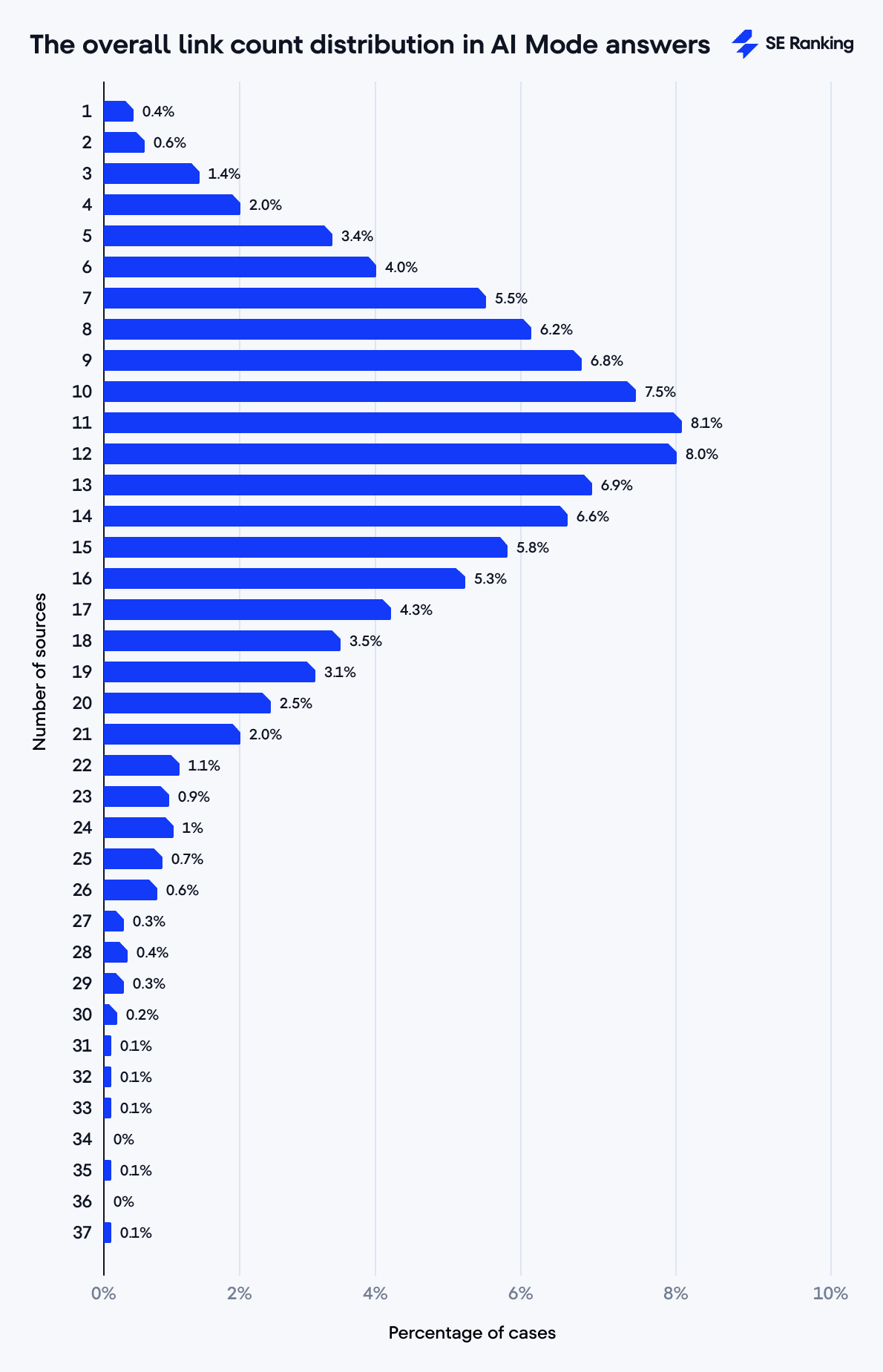
Only 39 responses contained just one link, and none had zero references. This reinforces Google’s goal of making AI answers more transparent and source-driven.
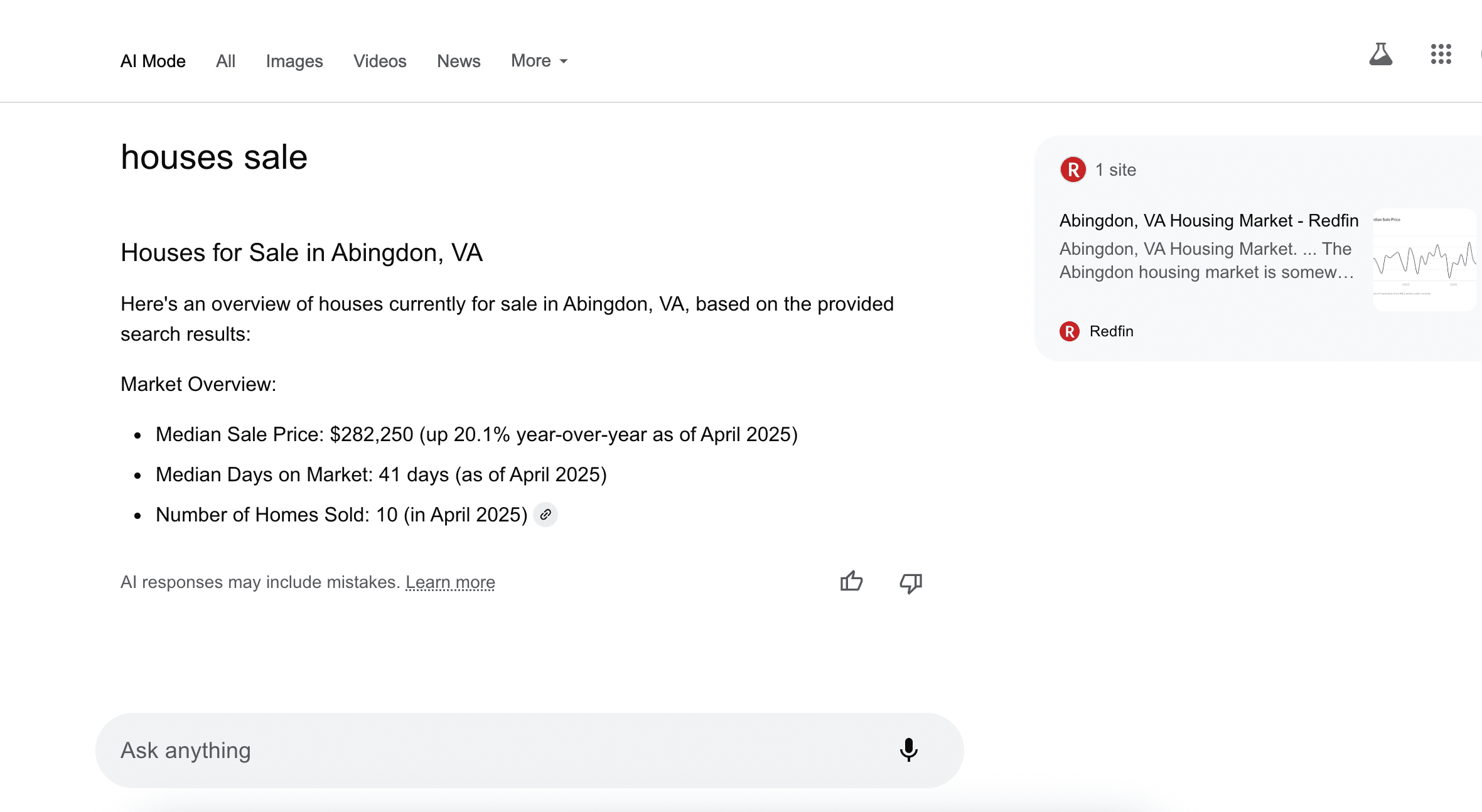
While most answers fall in the 6–15 link range, some go much higher.
2.5% of responses included more than 25 sources. Just 2 AIM responses cited over 50 references, with the highest totaling 58 links.
Let’s take a closer look at the recent things query (see the screenshot below).
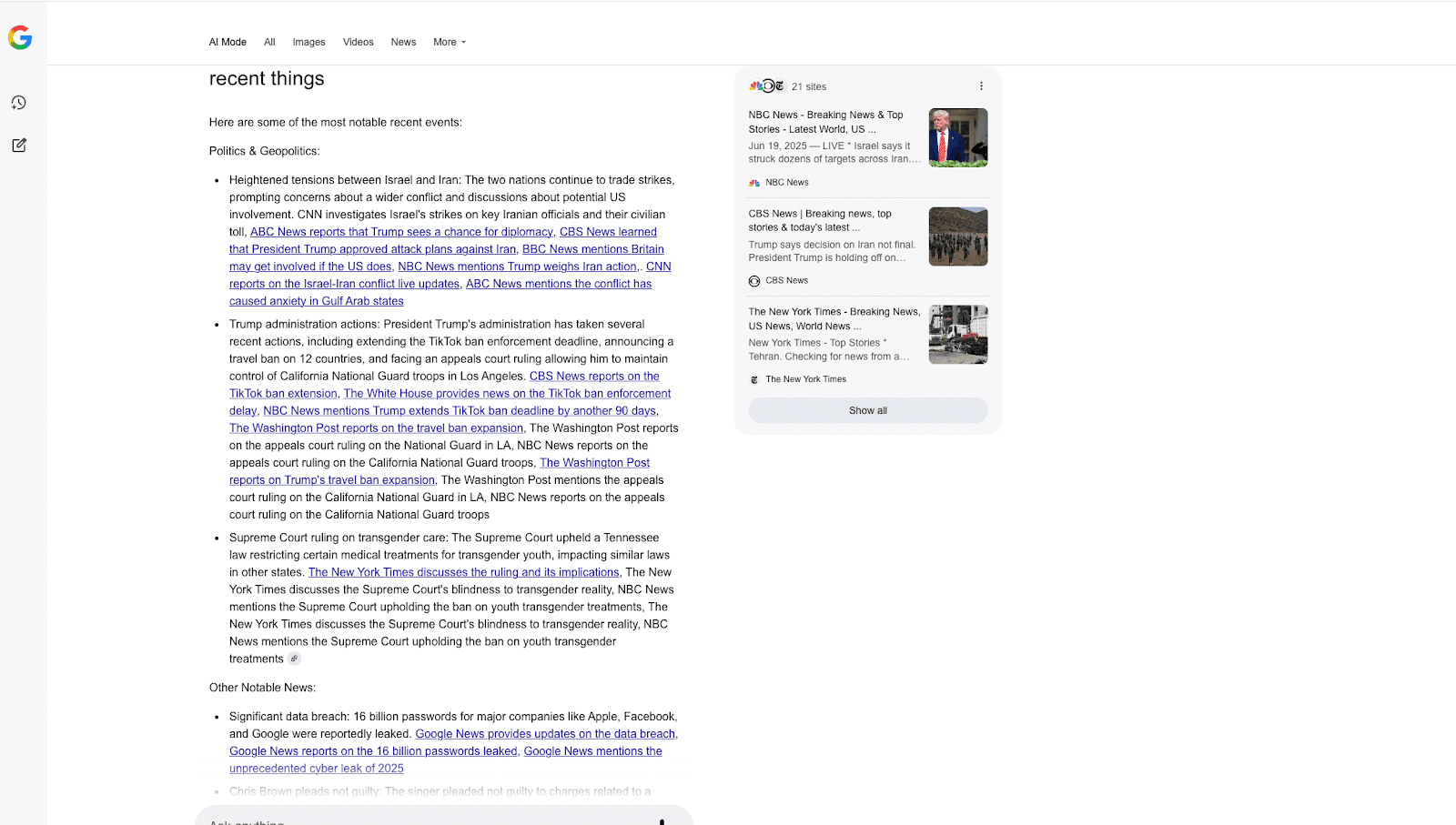
AI Mode’s answer includes a lot of in-text links that lead to news media. This is a selection of the most relevant recent events and news. When we asked the same query in AI Overviews, we didn’t get any response.
Our previous AIO research showed that 20.85% of AI Overviews include at least one citation from a recognized news media website. In this case, we had no AIO, so we can’t compare the results, but we can raise a fair question: Does AIM prefer media outlets more than AIO?
How often does AI Mode add sources directly into the response text?
AI Mode places links in multiple areas of the answer interface. Here’s the breakdown of all 122,617 links analyzed:
- 111,392 links (90.8%) are block links placed in a separate area to the right of the main text of the response.
- 10,915 links (8.9%) are in-text links integrated directly into the response’s text as traditional hyperlinks.
We also detected a new category of links that mimic organic search results. We’ll call them AIM SERP links. This is the smallest category, accounting for just 0.3% of all links (310 out of 122,617 links). These links were rare, found in only 79 responses out of 9,734 (0.8%).
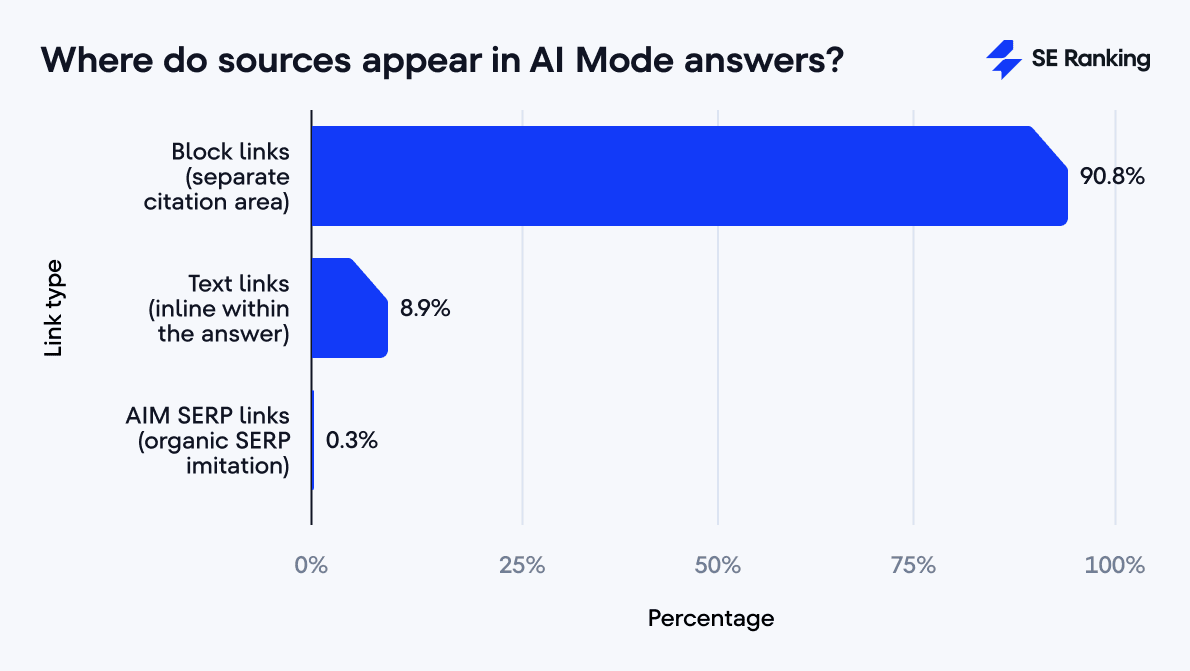
There seem to be two versions of AIM SERP links:
- A long version features up to 10 links and looks like a standard search results block.
- A short version is usually titled Quick results from the web and shows 2 links.
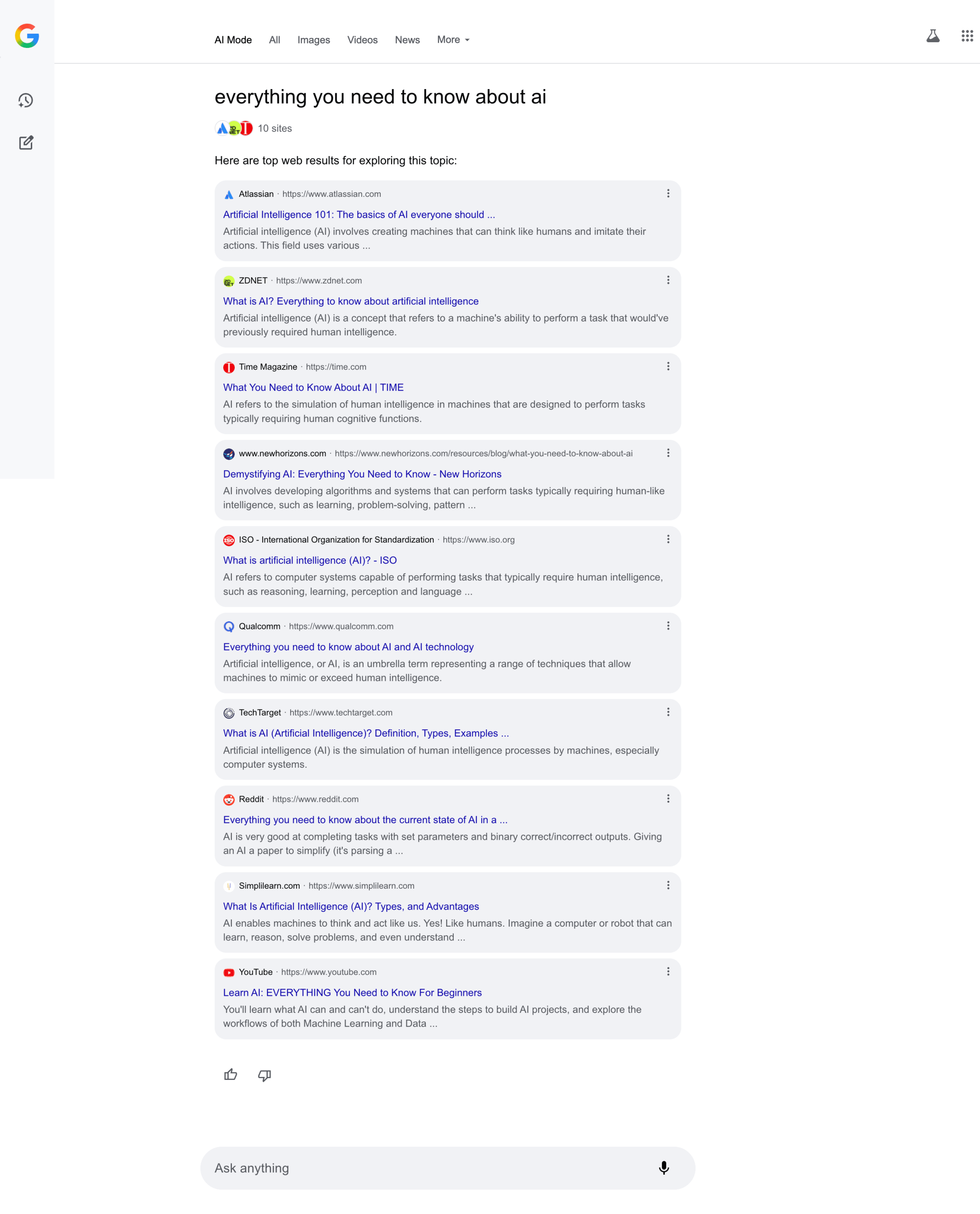
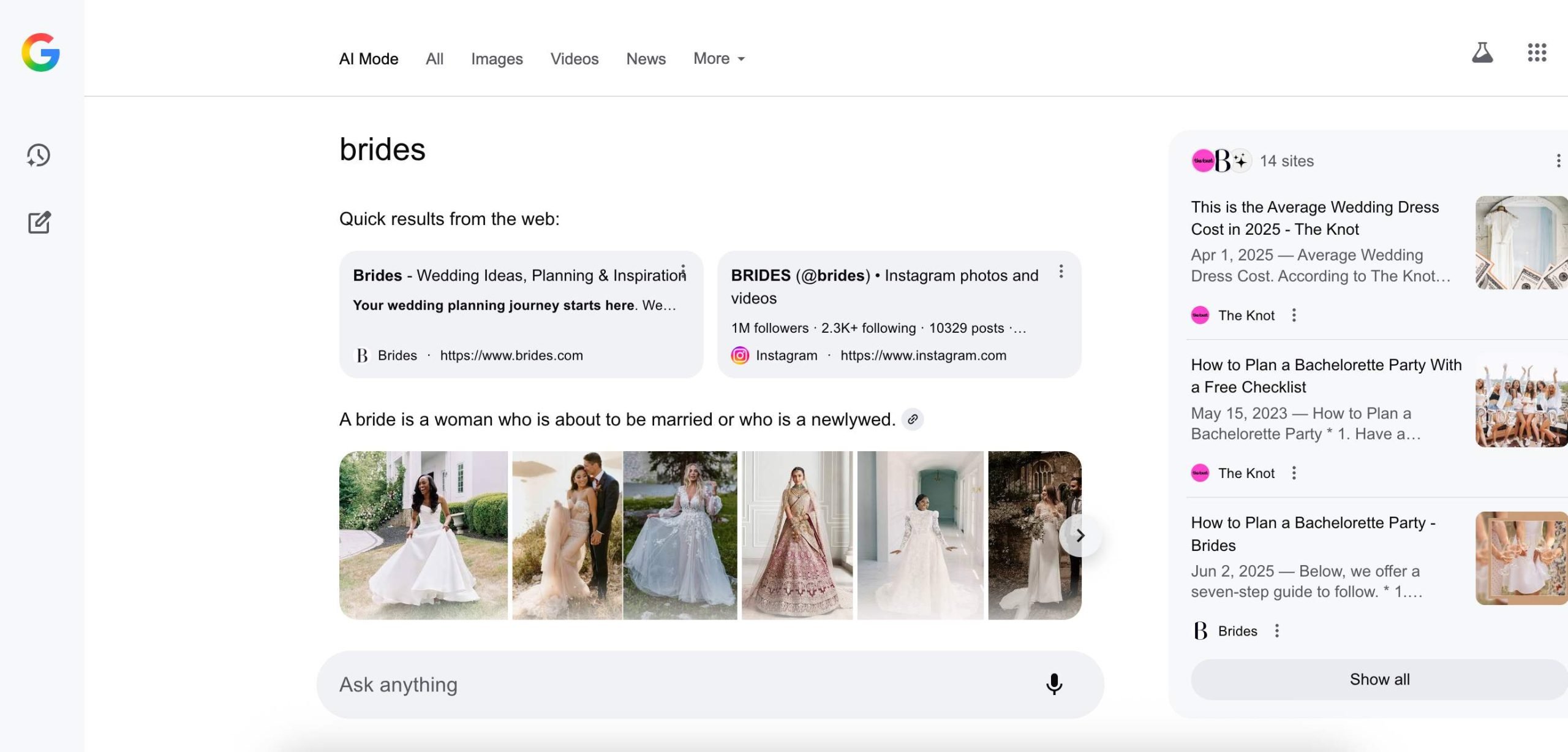
This is a new link style. We haven’t seen it before, neither in AI Mode nor in AI Overviews. AI Mode seems to be blending AI answers with classic search layouts. This could be a way to ease users into this new format or to test AI Mode’s merging with traditional search. On the other hand, the links placed at the very beginning of the AI Mode answer likely see higher CTR, giving featured websites a better shot at driving traffic.
How big is the source overlap between AI Mode and AI Overviews?
We used AI Results Tracker to collect AIO data on the same 10,000 keywords we used for AI Mode. We found discrepancies in the data. 4,368 keywords triggered AIO, making its overall rate 43.7%. This analysis used 4,281 queries with data available from both AIOs and AIM.
URL-level overlap
On average, the exact URL overlap between AIM and AIO responses was just 10.7%.
- 589 keywords (13.8%) had no overlapping URLs between AIO and AIM. No keyword exhibited a 100% URL match.
- 2,406 keywords (56.2%) had a URL overlap of 10% or less, another 1,355 keywords (31.7%) fell into the 10–20% range, and only 153 keywords (3.6%) showed a URL overlap above 30%.
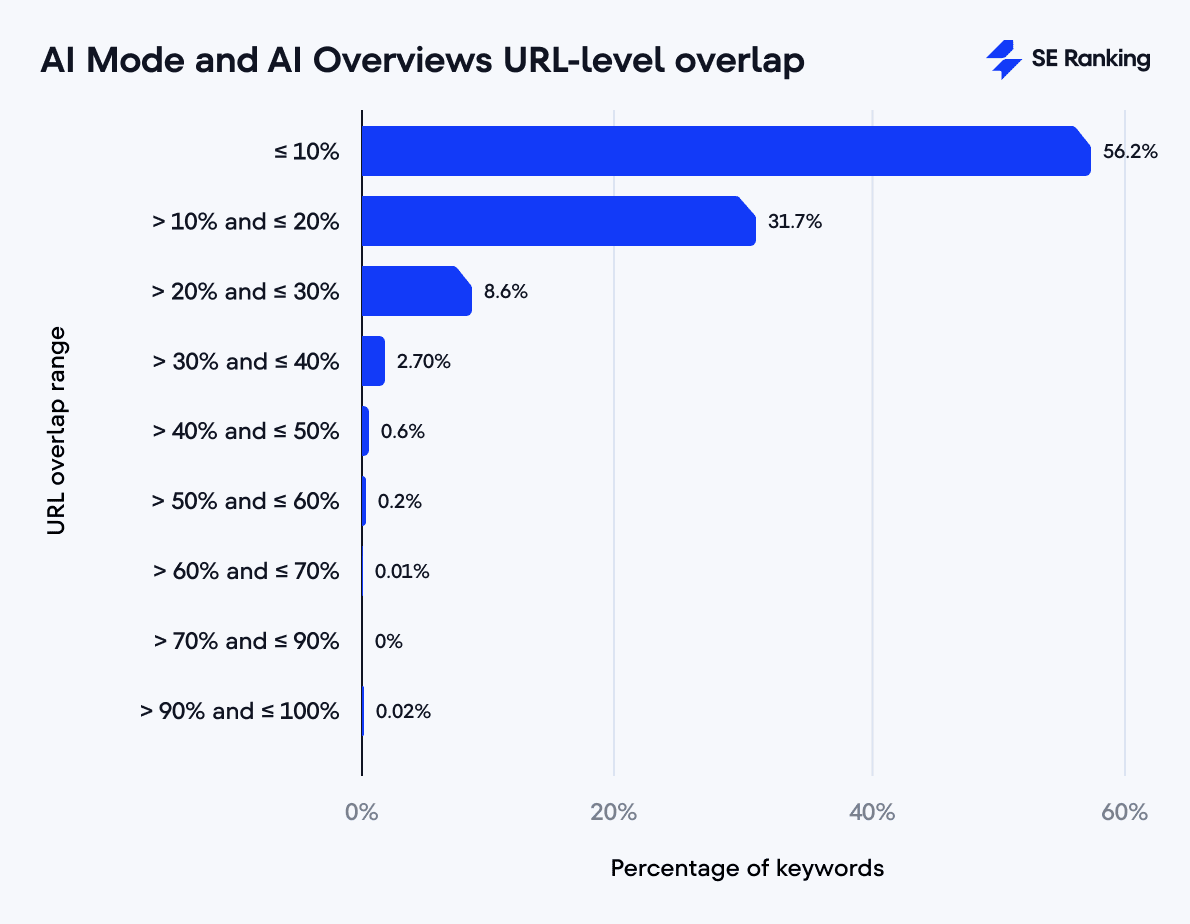
This low number highlights major algorithmic discrepancies in each system’s source selection process. AIOs and AIM may appear to be part of the same feature, but they behave very differently. That said, the results may be skewed by AI Mode’s high volatility.
Domain-level overlap
The overlap increases slightly when we look at domains instead of individual URLs. The average domain overlap between AIO and AIM results is 16%.
- 251 keywords (5.9%) had no shared domains at all.
- 1,422 keywords (33.2%) had a domain overlap of 10% or less.
- 1,657 keywords (38.7%) fell in the 10–20% range.
Interestingly, three queries stood out with a domain overlap as high as 90–100%. This suggests that, in rare cases, both systems can largely agree on source relevancy.
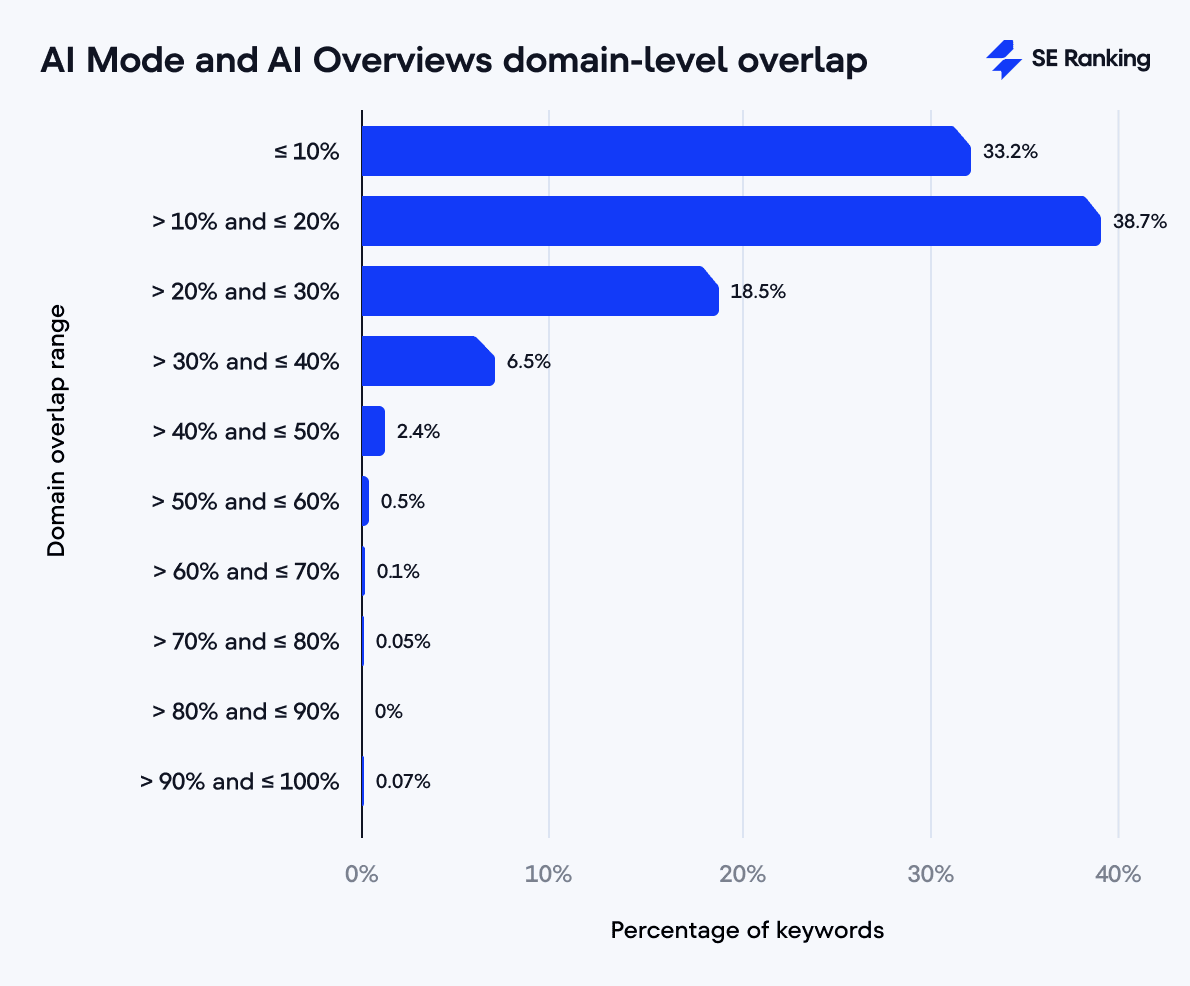
This shows that AIOs and AI Mode occasionally pull from the same websites, but rarely to the exact same pages.
How much does AI Mode overlap with organic search results?
We compared AI Mode responses with both the Top 10 and Top 20 organic results for 9,734 keywords (queries that AI Mode answered) to measure the appearance frequency of the same URLs and domains in both. Due to technical issues, we could only retrieve data for 9,721 queries out of 9,734.
Top 10 organic overlap
The average exact URL overlap is just 14%, and only 2.5 URLs overlapped per query.
Out of the 9,721 keywords we analyzed:
- 7,982 queries (82.1%) showed some overlap between AI Mode sources and organic top 10.
- 1,739 keywords (17.9%) resulted in no overlap at all.
- 3 keywords showed a 100% match with the Top 10.
This means that AI Mode rarely references the pages Google ranks highest in traditional search. It has a radically different approach to determining content relevance and quality.
The overlap improves slightly by domain. The average domain overlap is 21.9%, and 3.1 domains per query.
- 8,981 keywords (92.4%) showing at least one shared domain.
- 740 queries (7.6%) exhibited no shared domains.
- 11 keywords (0.1%) resulted in a 100% match.
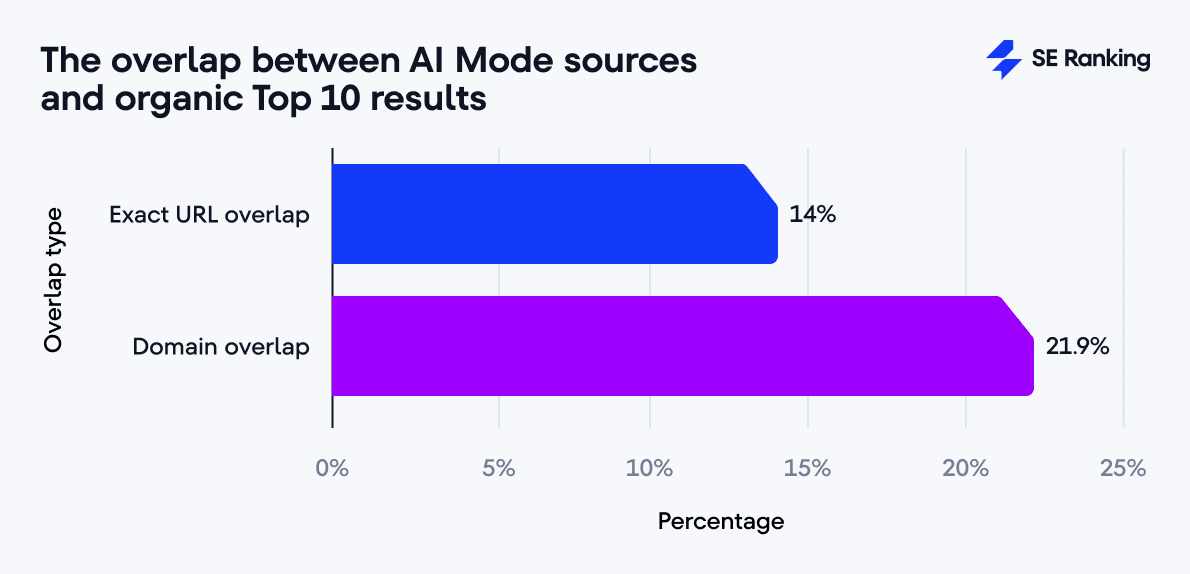
Top 20 organic overlap
When the top 20 organic results are factored in, overlap with AIM is even smaller. The average URL overlap drops to 12%.
This means AI Mode rarely uses pages that rank between positions 11 and 20 in organic search. It appears to prefer sources beyond the traditional ranking structure.
More detailed analysis shows that:
- 8355 keywords (92.4%) had at least one overlapping URL
- 13.66 keywords (5.1%) had none
The average number of shared URLs per query is 3.2, which is 0.7 higher than the absolute average number of links in the top 10.
The situation is slightly better at the domain level. The average domain overlap is 18.6%, with the average number of shared domains per query being 4.1.
- 9,226 keywords (94.9%) had at least one shared domain
- 495 keywords (5.1%) had no overlap
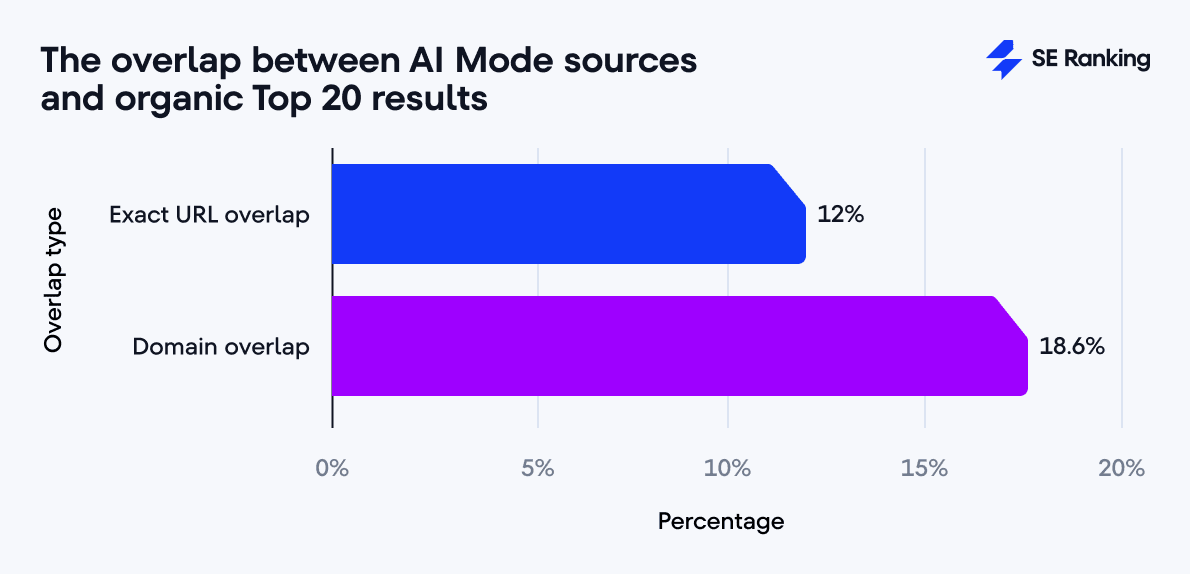
These findings highlight a fundamental difference between AI Mode and traditional Google search. They also show how both systems assess content relevance and authority. Even if a page ranks in the top 10 organically, that doesn’t guarantee it will appear in an AIM response.
AI Mode uses a different set of rules from standard SEO signals.
Where do AIM SERP links come from?
We found an answer to this question by measuring the Coverage Rate. This is the percentage of links in the AIM SERP that also appear in the Top 10 or Top 20 organic results for the same query. Here’s what our results revealed:
- On average, 87.3% of links in AIM SERPs within AI Mode answer come from the top 10 organic results, and 88.5% come from the top 20.
- 90.1% of domains cited in AIM SERPs come from the organic top 10, and 91.5% come from the top 20.
Out of 79 analyzed keywords that triggered AI Mode answers with AIM SERP links:
- 74 queries (93.7%) have at least one in AIM SERP from the organic top 10/20.
- 75 keywords (94.9%) resulted in at least one domain from the top 10-20.
- 5 keywords (6.3%) had no links from the top 10/20 at all.
- 4 queries (5.1%) had no domains from the top 10/20.
- 57-64% (72.2%-81%) keywords resulted in all links in AIM SERPs coming from the Top 10/20, both in terms of exact URLs and domains.
This supports the idea that the AIM SERP section closely mimics and pulls from organic SERPs, suggesting a possible move toward deeper integration between AI mode and traditional search.
Also, Google notes that when they aren’t sure about the factuality of AI Mode responses, they might add a selection of web search results (a section with organic links that we call the AIM SERP). Though the overall share of these links in our dataset is less than 1%. This could mean that Google is confident that AI Mode answers are high quality and meet user needs better than organic data.
How stable are AI Mode results?
We ran a volatility test to see how consistent AI Mode is. Our goal was to see whether different users receive the same answers when searching for the same queries and the degree to which results can vary depending on user location and other personalization factors.
We analyzed a fixed set of 10,000 keywords three times on the same day. We ran each test independently to capture AI Mode’s response to different users at different times.
In total, AI Mode responded to 9,451 keywords during all three rounds.
The overlap of sources between the three sets of AI Mode answers
The average overlap of exact URLs between the three datasets was just 9.2%. This means that AI Mode often chooses completely different pages each time, even when the query doesn’t change.
- 2,006 keywords (21.2%) had no overlapping URLs at all between the three tests
- 6 keywords (0.1%) had a 100% URL match in all three answer sets
This means it’s rare for AI Mode to consistently pull from the same pages, even for repeat searches.
When we zoom out and look at domains instead of individual URLs, the consistency improves slightly. The average domain overlap of domains between the three datasets is 14.7%.
- 914 keywords (9.7%) had no shared domains at all
- 21 keywords (0.2%) had a 100% domain match in all three answer sets

This suggests that, while AI Mode may cite different pages, it sometimes still pulls from the same websites. On average, AI Mode cites 5.2 URLs from the same domain, excluding www.google.com links. And although this means that different pages of the same cluster can rank for the same keyword, AI Mode results can change a lot, even for the same query. The content you see may depend on when you search, where you’re located, or how AI Mode interprets your intent in that moment.
Pairwise comparison of overlapped sources between all three sets of AI Mode answers
We analyzed the results in pairs and compared two datasets at a time to see how stable AI Mode was. This method provided a more balanced view because it didn’t require that the same URLs or domains appear in all three sets at once. If it did, this would make the overlap appear lower than it really was.
When we compared the datasets in pairs, we found that overlap rates were slightly higher, especially at the domain level:
- The first and second datasets share 18.5% of URLs and 26.7% of domains.
- The first and third datasets share 18.5% of URLs and 26.6% of domains.
- The second and third datasets share 19% of URLs and 27% of domains.
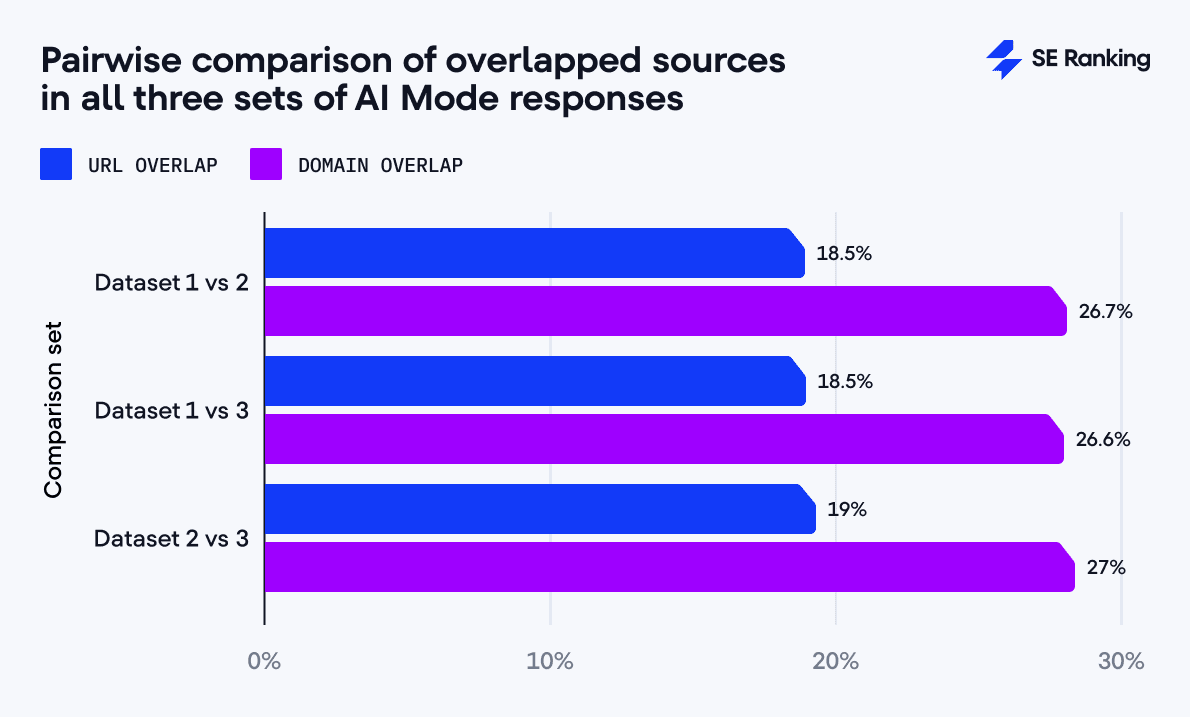
On average, each keyword resulted in 3.3 identical URLs across any two sets of answers and 3.7 identical domains.
This shows that AI Mode sometimes repeats itself when you run the same search twice, but the overlap is still modest. The results remain inconsistent when looking across all three answer sets at once. Only a small portion of sources remain consistent across multiple searches for the same query. So, predicting or securing inclusion in AIM results is quite complex.
We also looked for unique and exclusive domains in each dataset. Unique domains are the total number of different websites used in a single dataset, without counting duplicates. Exclusive domains are domains that appear in only one dataset and are completely absent from the other two.
Here are our results:
- Dataset 1: 22,235 unique domains and 8,306 exclusive to this set
- Dataset 2: 22,423 unique domains and 8,349 exclusive ones
- Dataset 3: 22,581 unique domains and 8,504 exclusive ones
Only 8,910 domains appeared in all three datasets, while 16,585 domains appeared in at least two.
So, each dataset resulted in thousands of domains that didn’t appear in the other two, even though all answered the same set of queries. This shows just how volatile AI Mode is when it comes to source attribution.
Top-cited websites across all three sets of AI Mode answers
Despite AI Mode’s high source selection volatility, one interesting pattern stands out: the top websites remain relatively stable across all datasets.
- www.google.com is the #1 mentioned domain in all three datasets, with its share of citations fluctuating only slightly between 5.5% and 5.7%.
- www.indeed.com consistently holds second place with 1.7% to 1.8% of all citations.
- en.wikipedia.org consistently appeared in third place with 1.6% of all citations.
- www.reddit.com comes fourth across all datasets, fluctuating between 1.3% and 1.5% of all citations.
- youtube.com ranked fifth in the first two datasets (between 1.3% and 1.4%), but dropped to sixth in the third (1.2%)
Despite variability in the specific pages and domains AI Mode pulls from, it relies on a core group of “preferred” websites. This suggests it treats them as consistently authoritative. This trend mirrors what we’ve seen in our AI Overviews research studies.
A note on local relevance
While analyzing the three datasets, we also noticed a separate but important trend: AI Mode often adjusts its answers based on the user’s location, even when the query doesn’t include any geographic details.
Many responses included location-specific information. This suggests that AIM attempts to personalize results and increase relevance by factoring in where the user is searching from.
Here are several examples:
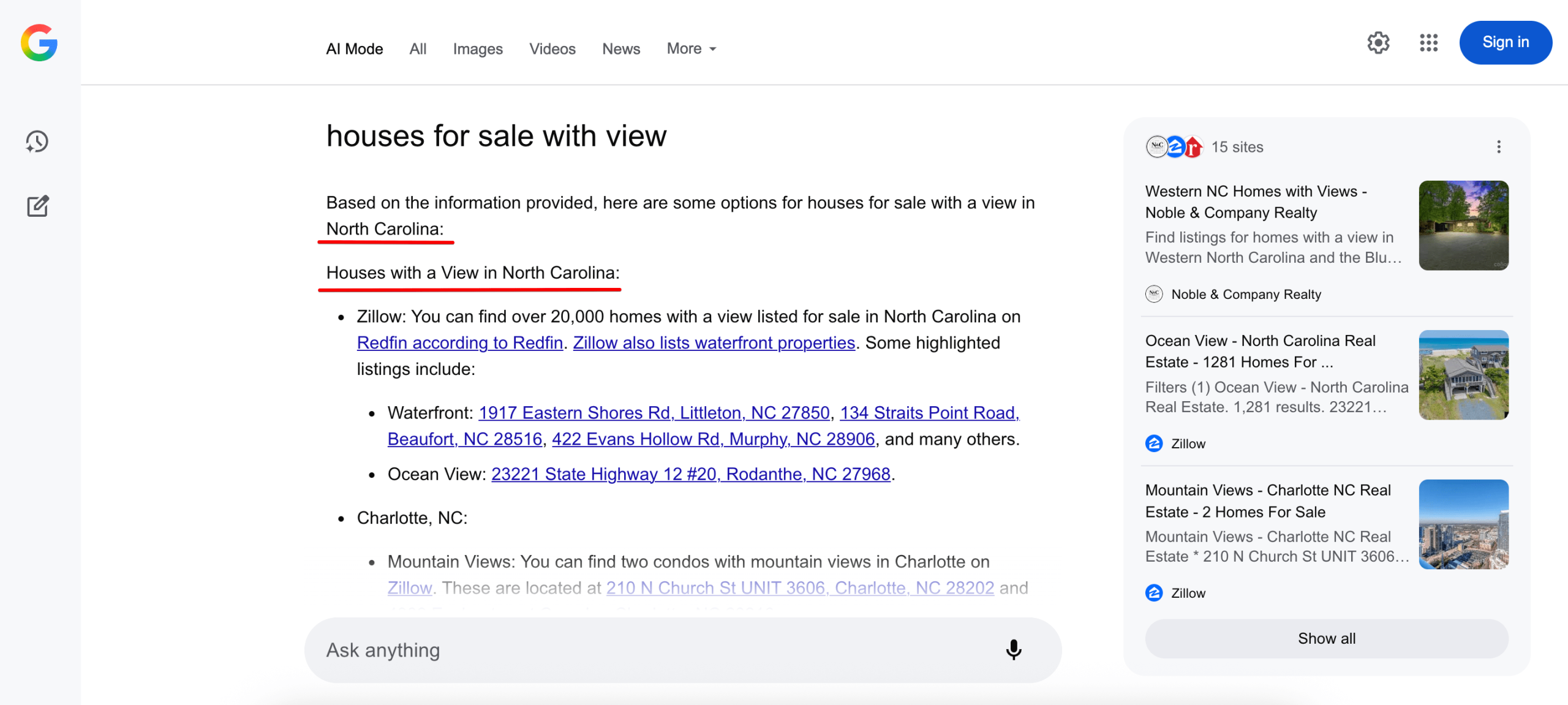
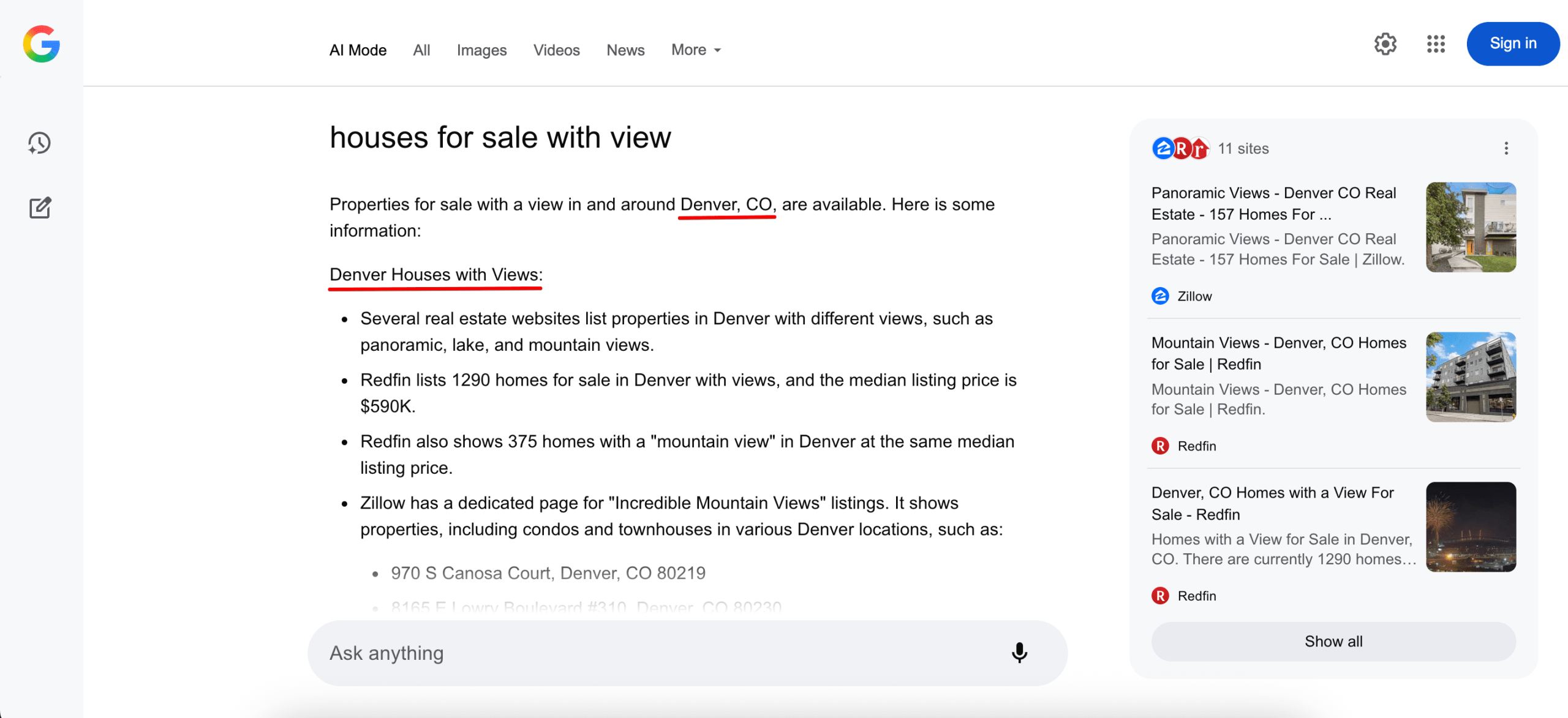
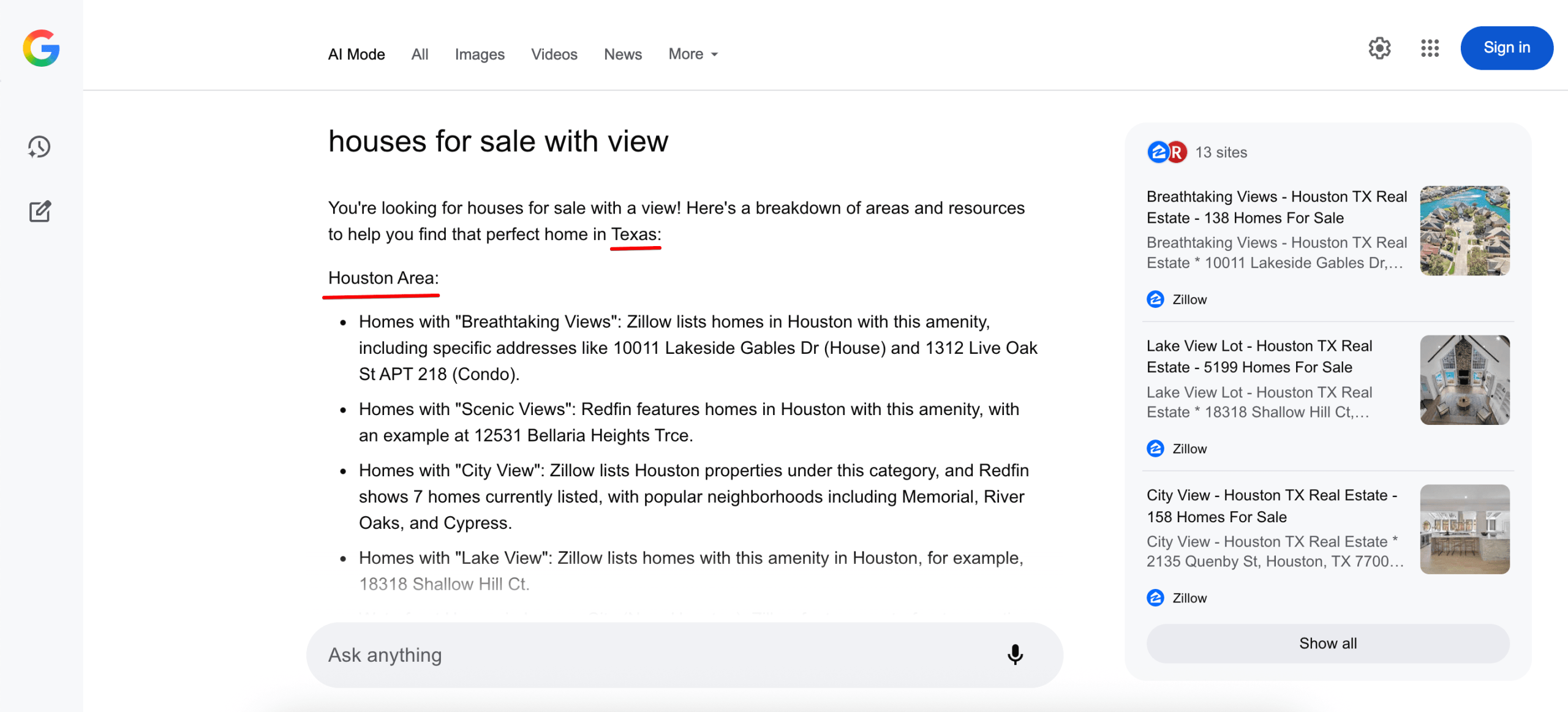
This behavior highlights AIM’s focus on contextual understanding. This could be the first step to including personal context in AI Mode answers.
Which websites show up in AI Mode answers?
In total, across 9,734 responses, AI Mode cited 22,235 unique domains. On average, that’s about 2.29 different websites per response. This is a notable variety, especially given that each response contains 12.6 links on average. This means AI Mode tends to reference multiple pages from the same domains in each answer.
Who gets cited the most?
The top 5 cited websites are:
- www.indeed.com: 2,202 citations (1.8%)
- en.wikipedia.org: 1,978 citations (1.6%)
- www.reddit.com: 1,799 citations (1.5%)
- youtube.com: 1,693 citations (1.4%)
- www.nerdwallet.com: 1,523 citations (1.2%)
The graph below shows that websites ranked 6-10 have similar shares of citations.
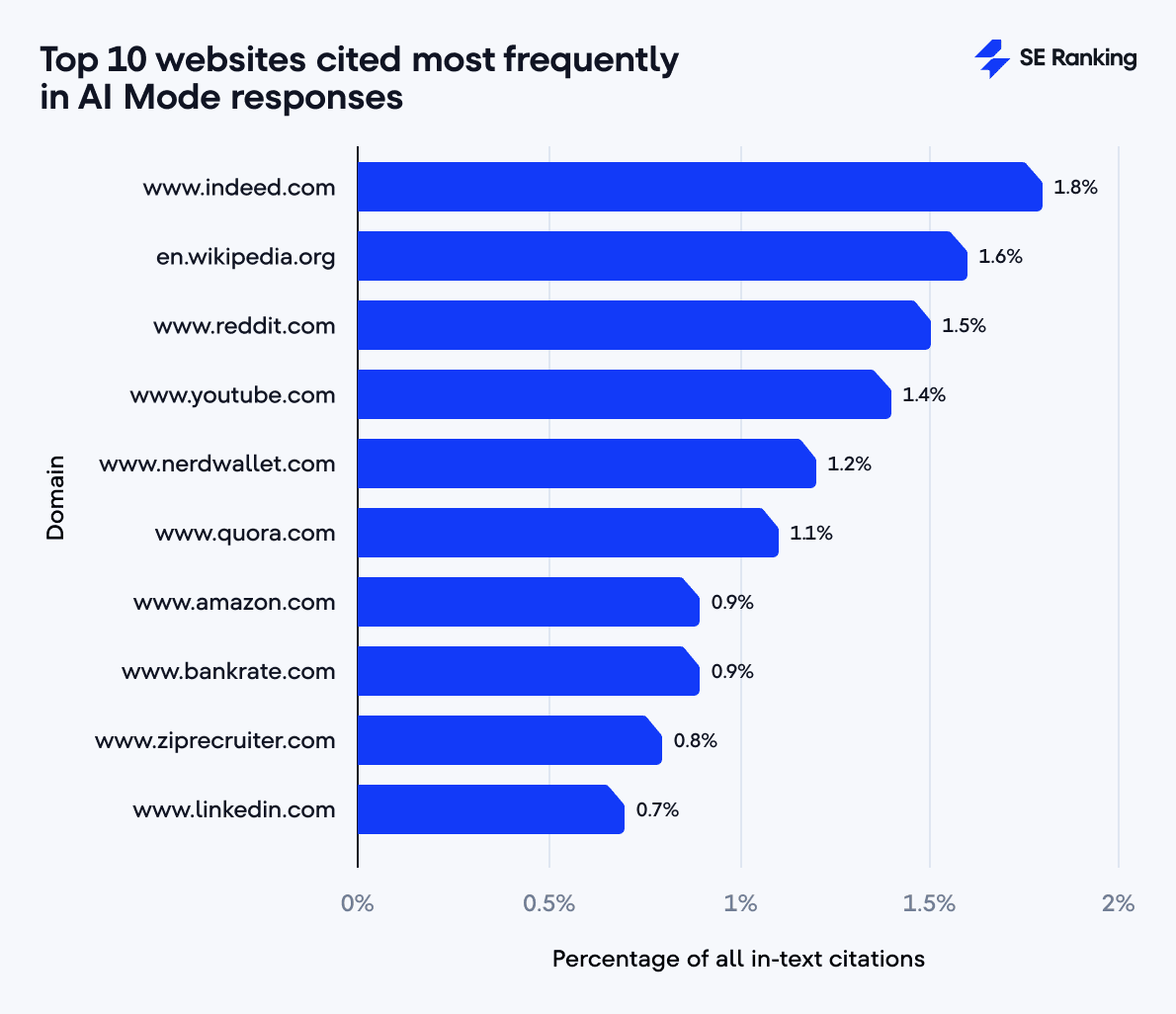
In our earlier research on AI Overviews, the top-cited domains looked quite different: YouTube and Reddit ranked second and third.
Together, the top 10 domains shown above account for 11.9% of all citations.
How does AI Mode reference Google in its responses?
We decided to look at Google separately because AI Mode approaches source attribution differently.
Google (www.google.com) is technically the most cited domain, with 6,971 links (5.7% of all citations). Moreover, it was the most cited domain across all three datasets when we tested volatility (5.5%-5.7%). We’ve seen something similar in our previous AI Overviews study, where Google self-referenced itself in nearly 44% of AIOs across the US. But this case is different because AI Mode links to other Google services, not organic search results.
Looking only at links embedded directly into the response text (10,915 in-text links), the dominance of www.google.com becomes even clearer: 6,833 in-text links (62.6%). But note that these generally aren’t links to new organic search results, but to business profiles and other Google services. This suggests AI Mode relies heavily on Google services for specific details.
Most of www.google.com links (6,824 links or 97.9%) pointed to Google Maps business profiles. These links appeared in 902 responses (9.2%), and came both as in-text links and in a similar format to the Places sites block from regular search results. This shows that AI Mode actively uses Google Maps (and similar services) to provide accurate local information. This is a good sign for local SEO and local businesses.
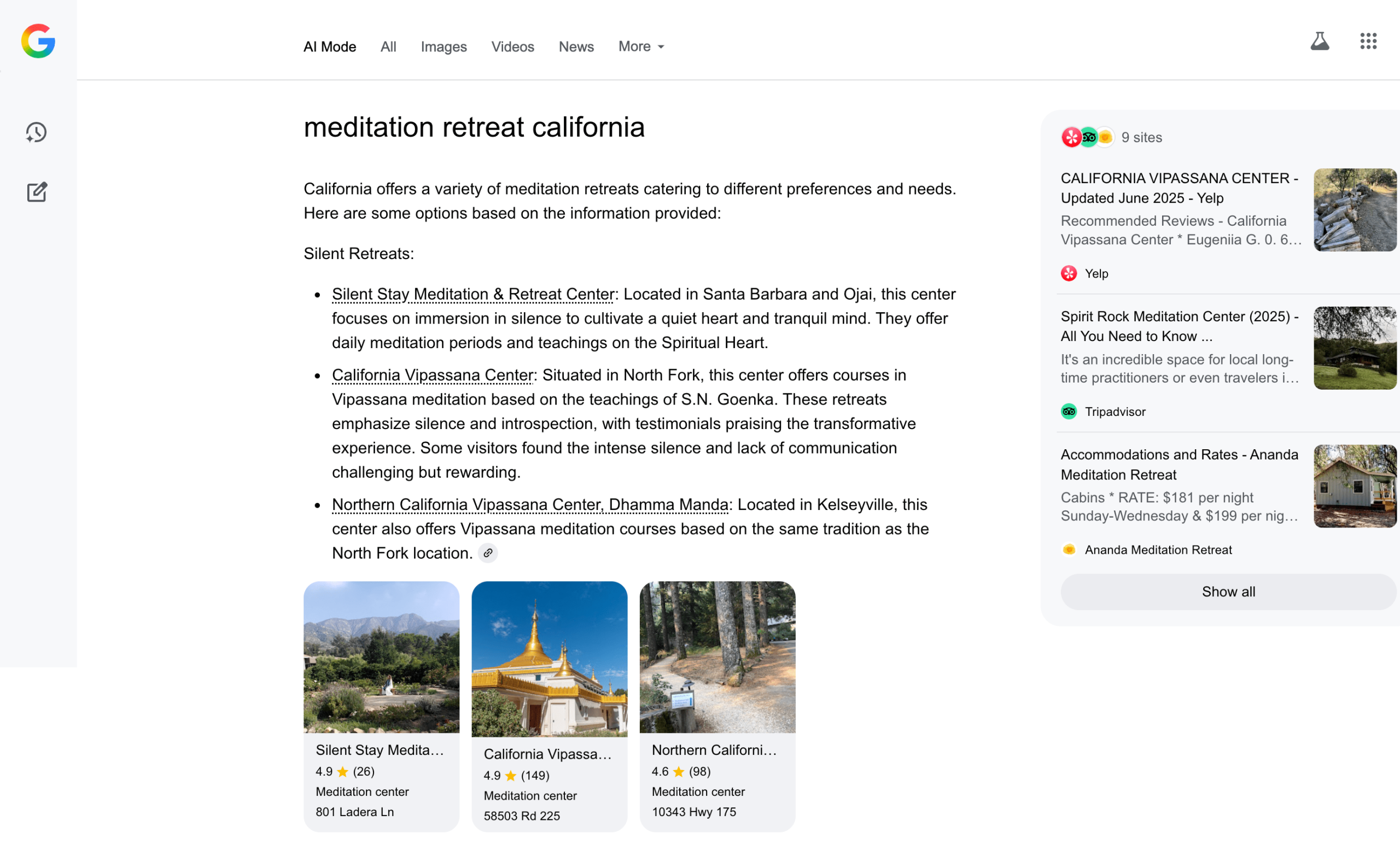
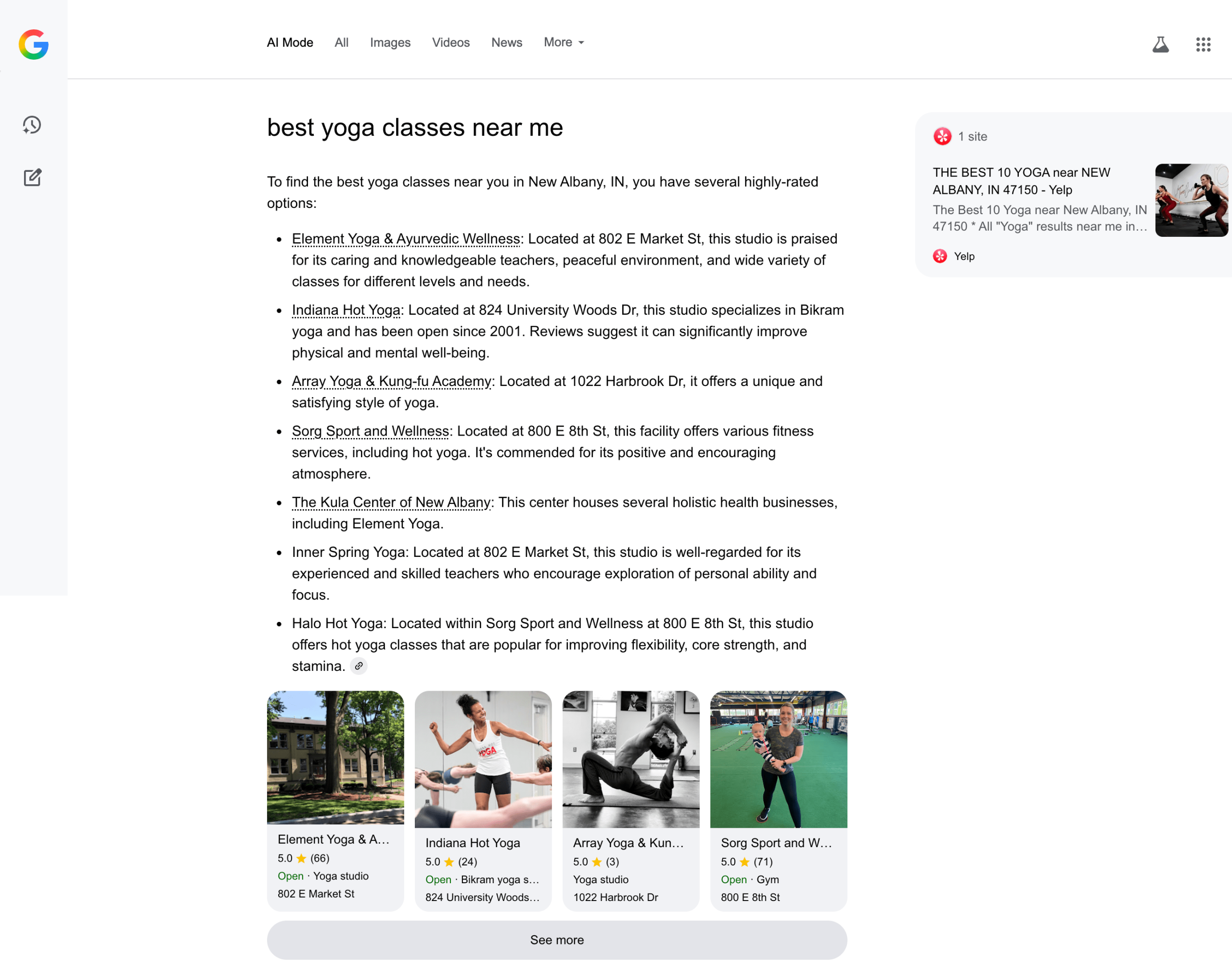
Clicking on the business card reveals a business information pop-up on the right side with NAP data, reviews, and photos.
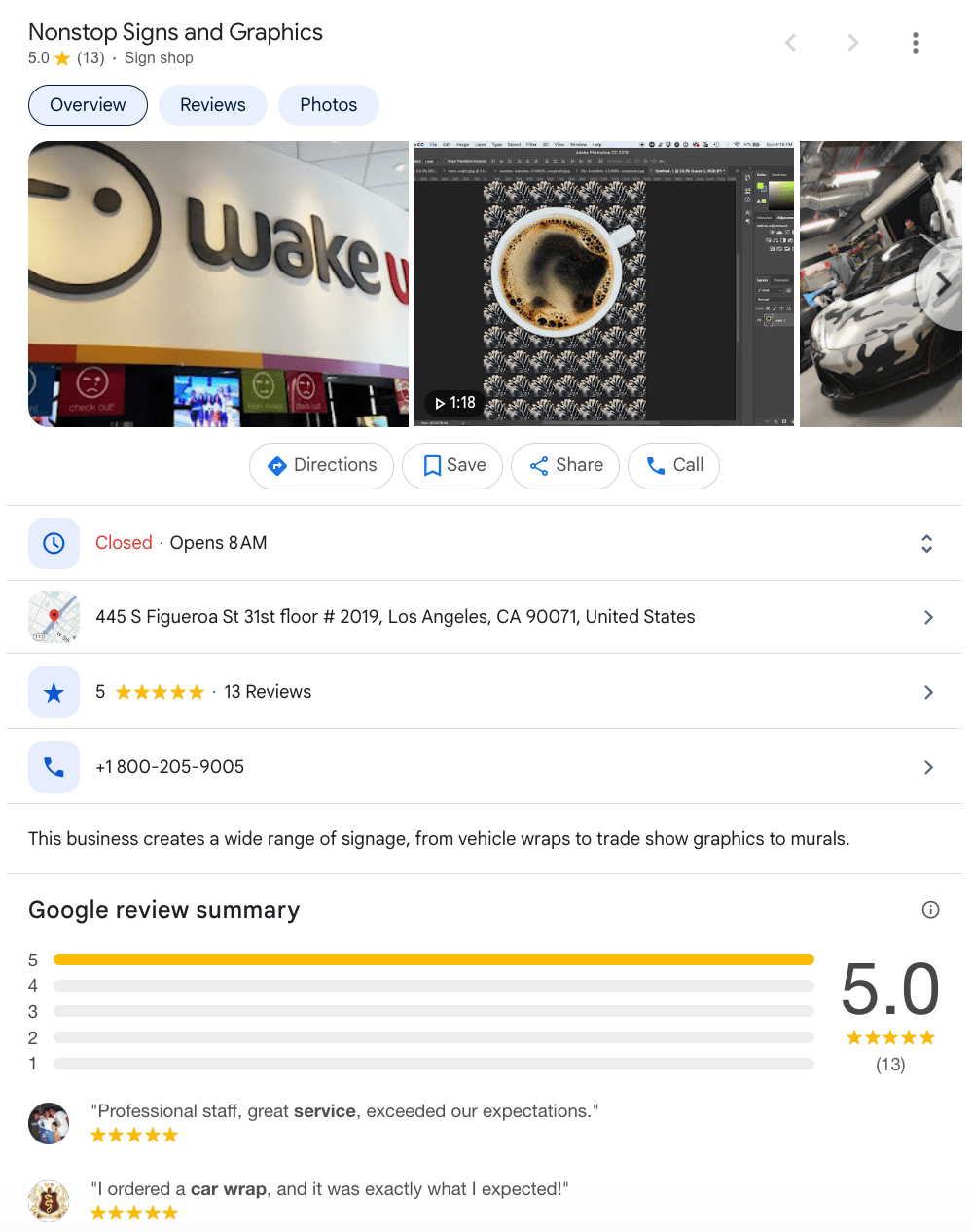
The More about button appears at the bottom and leads you to the brand’s organic search results page. Still, AI Mode offers some visibility to businesses by surfacing their information directly—unlike AI Overviews, which often push users toward traditional search results instead.
AI Mode also occasionally links to other Google services:
- Google Travel (e.g., flights, hotels): 137 citations
- Google Finance: rare but present
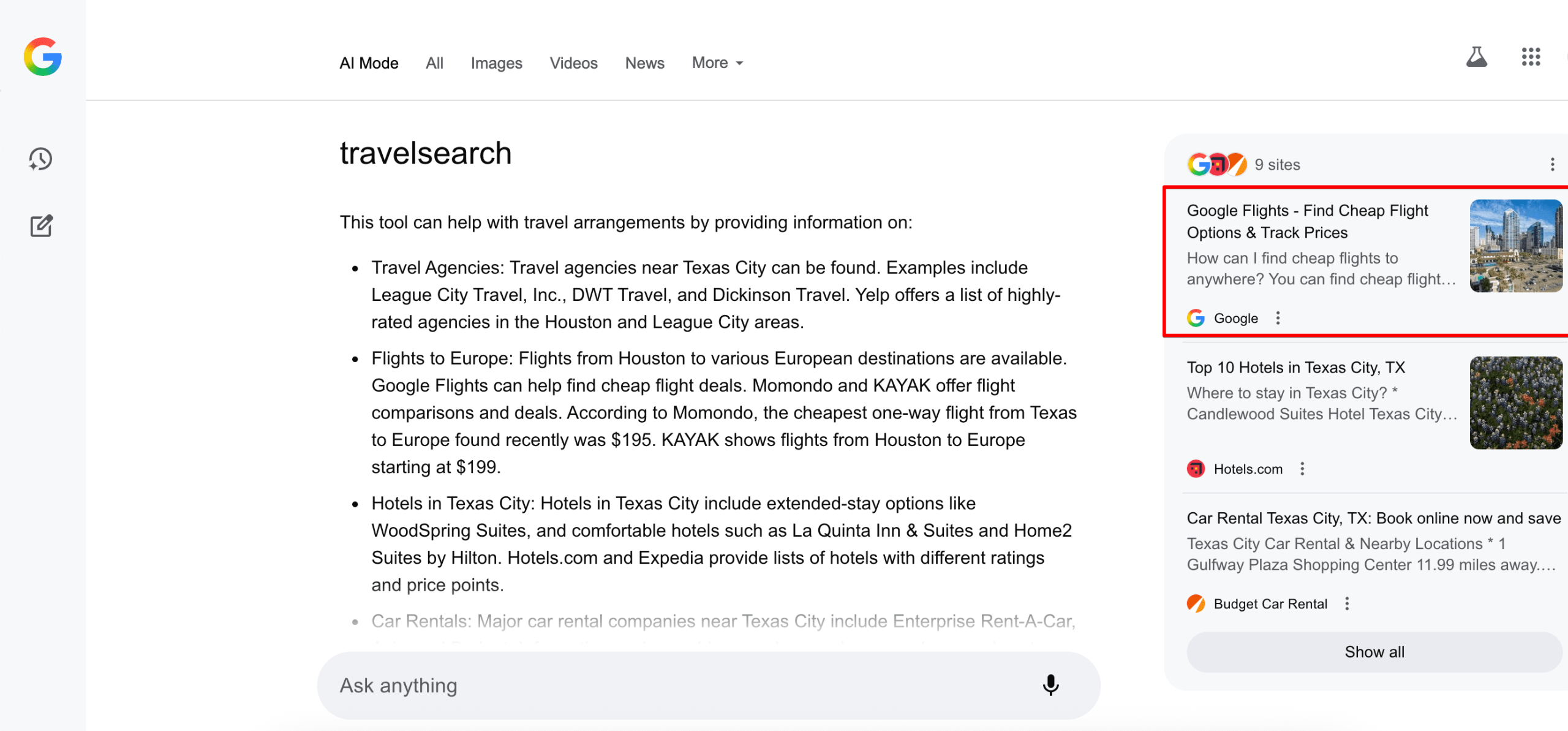
Although AI Mode can link to brand SERPs through the business profiles it pulls in, our analysis showed no direct links to traditional organic search results or to other AI Mode results from AI Mode responses. This means that while AIM pulls heavily from Google’s own ecosystem, it stops short of linking back to the core search index itself. AI Mode could also eventually become the new default version of search, so there would be no point in sending users back to the “old” SERP in that kind of landscape.
Who gets cited directly in AI Mode answers most often?
This section looks at the most frequently cited websites directly in AI Mode text answers (in-text links).
- www.amazon.com is the leader here with 96 in-text links (2.4%).
- youtube.com comes second, meaning that when it’s mentioned in AI Mode answers, its links are more often included directly in the response text.
- The top 5 in-text cited domains do not overlap with the top 10 most-cited domains overall.
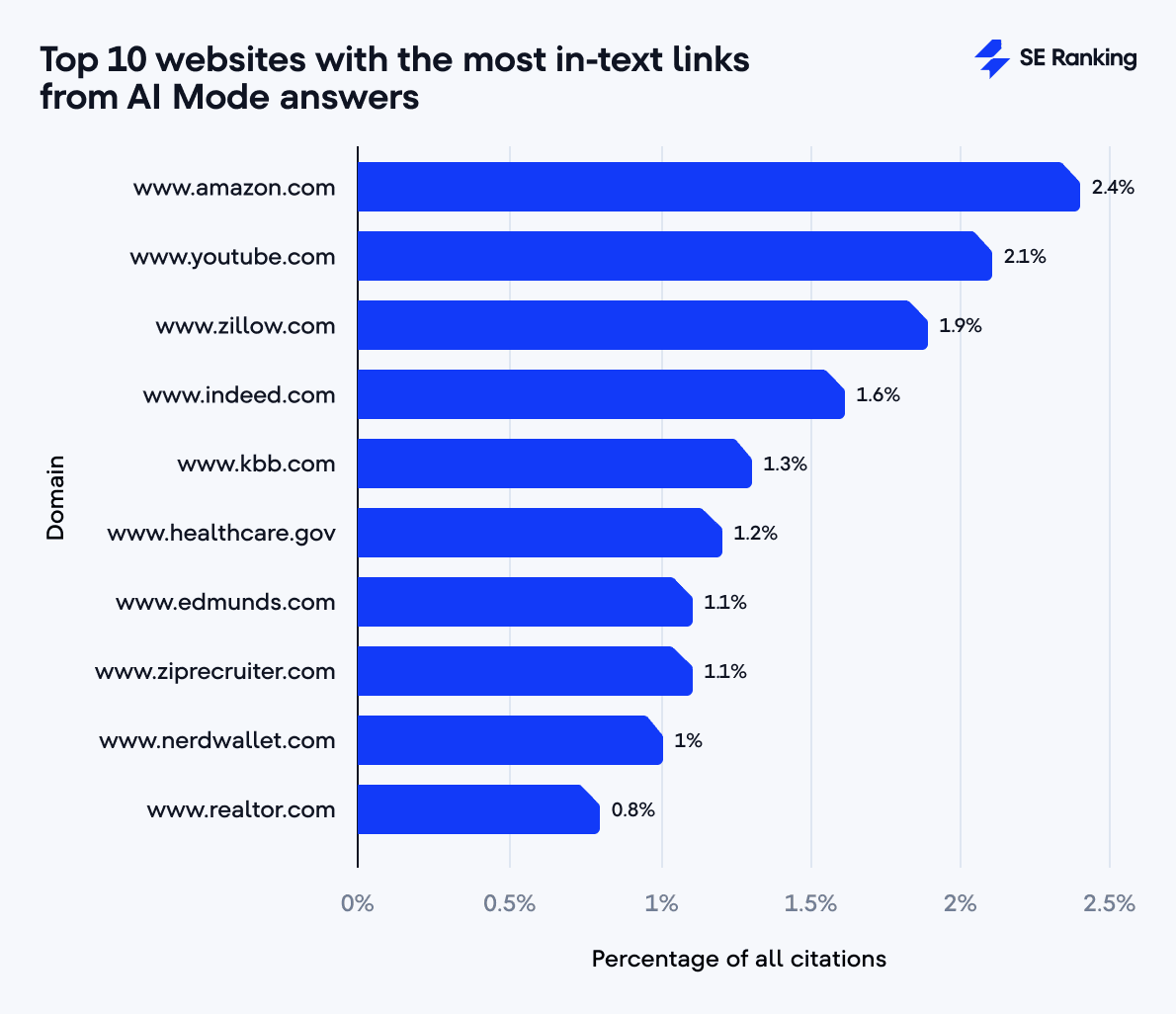
Research methodology
This study used a sample of 10,000 keywords to analyze the behavior of Google’s AI Mode.
We collected all the data on June 20, 2025. To assess volatility, we conducted several independent parses of the same keyword set on the same day. We used different account settings (both logged-in and non-logged-in Google accounts. The data in this research is based on non-logged-in Google accounts. However, results across all parses were similar.
We input all queries from the United States.
Below are the SE Ranking tools used for analysis:
- Keyword Research Tool: To prepare our keyword list
- AI Results Tracker: To collect AIO data
To compare and contrast the responses across all three rounds, we used a mathematical formula called the Jaccard coefficient. It’s a common method for measuring similarity between datasets.
For each keyword, we analyzed the URLs and domains cited across all three answer sets. Then we calculated:
- The intersection: the number of sources that appeared in all three responses.
- The union: the total number of unique sources across all three responses.
We then divided the intersection by the union to get a Jaccard score—a percentage representing overall source overlap.
Wrapping up
AI Mode is nothing like AI Overview or traditional search. It follows its own logic, and we’re all still trying to decode it. But one thing is clear. Search isn’t leaving, it’s just becoming AI.
Here are some things to consider for now:
- AI Mode often pulls sources that don’t appear in the top 10 or top 20 organic results. Optimizing for it requires a broader content strategy, not just chasing SERP positions.
- Google appears to favor domains that it considers trustworthy and informative. This means you still need to work on your domain’s authority.
- AI Mode results vary across sessions, locations, and users. This means visibility will depend on consistency, topical coverage, and adaptability, not one-time wins.
- Google products are deeply embedded in AI Mode responses. Make sure your business or content is visible within these systems. This could influence your chances of appearing in AIM answers.
This study is just the beginning. We have plans to continue researching AI Mode as the industry shifts. Stay tuned for more insights. In the meantime, check out our AI Search Toolkit. It’s packed with features for optimizing visibility in AI-generated results and will soon cover AI Mode tracking.
